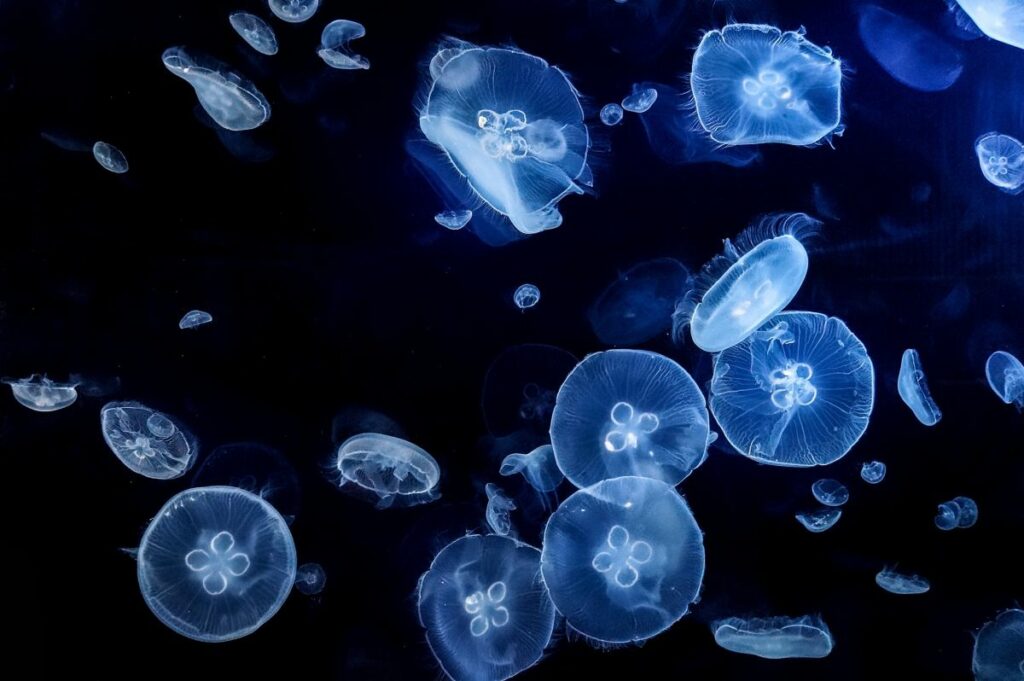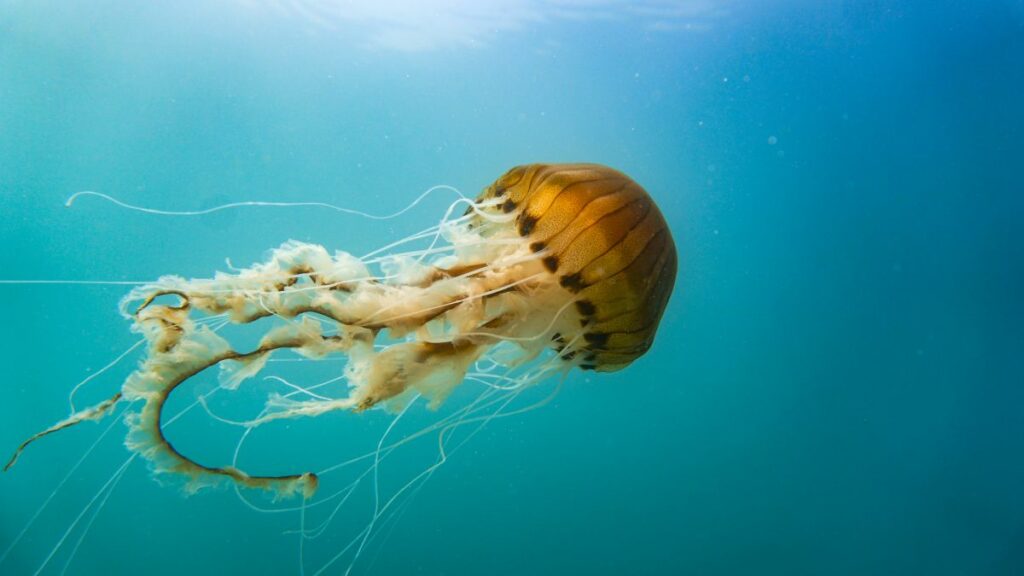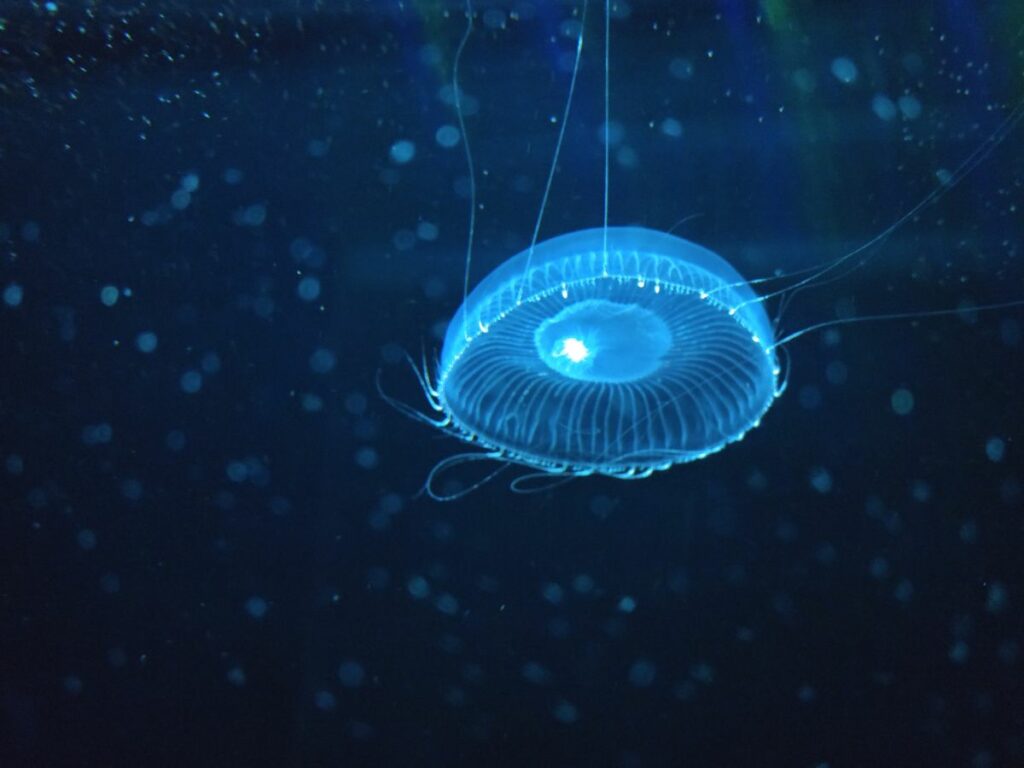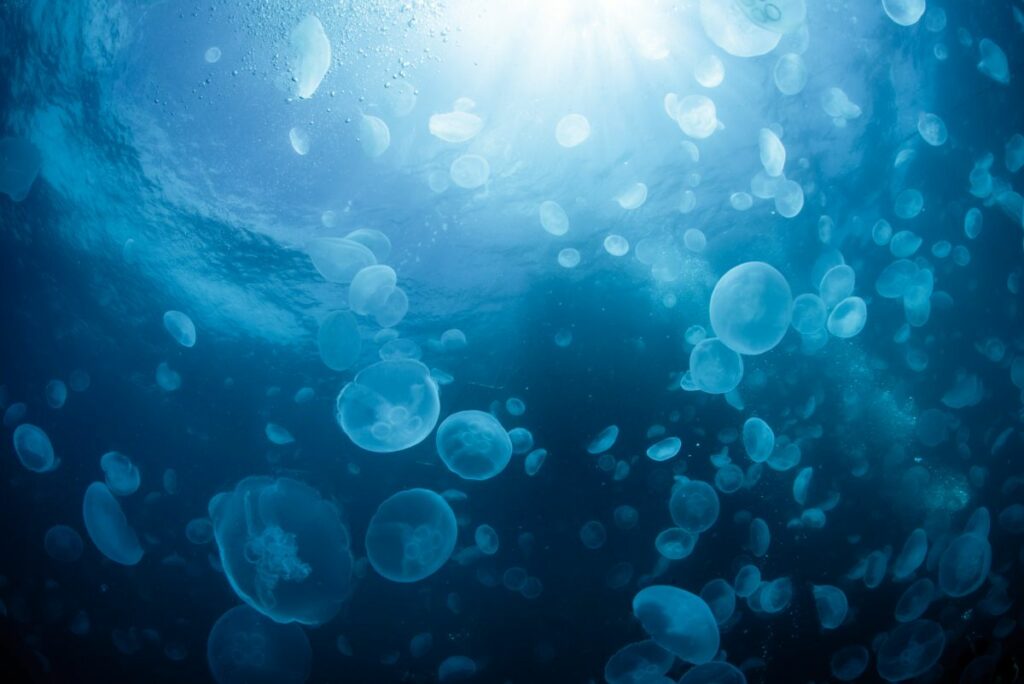Jellyfish are enchanting creatures that live all across the world’s oceans. Their bodies are simple, and they can’t think, but they play a huge role in the ocean. Over 2,000 known species of jellyfish exist ranging in size from a few millimeters to several meters long.

Jellies may look freaky, but most pose little danger to humans other than a temporary sting.
Whether you think jellyfish are terrifying or fascinating, there’s no doubt that there’s something about these creatures that continues to keep people captivated.
1. What Are Jellyfish?
Jellyfish are cnidarians, a type of invertebrate that has stinging cells in its tentacles. There are thousands of species of jellyfish around the world ranging in size from just a few millimeters to hundreds of meters long.
Despite their stinging tentacles, most jellyfish are harmless to humans besides a bit of temporary pain. Some jellyfish, like the box jellyfish, cause excruciating stings that lead to cardiac arrest within minutes.
Jellyfish are simple animals that comprise 95% water. The rest of their body comprises three layers. The outer layer is the epidermis, and the inner layer is the endoderm gastrodermis. In the center is the mesoglea, a thick layer of gelatinous material which gives jellyfish their jelly-like appearance.
2. Where Do Jellyfish Live?
Jellyfishes are drifters who mostly “go with the flow”. Because they comprise mostly water, they are weak swimmers and let the currents take them anywhere. Jellyfish don’t have a distinct habitat and live almost everywhere, but they prefer coastal waters.
Most jellyfish live in the “twilight zone”, the area of the ocean that is between 200-1,000 m (656.2-3,280.8 ft) below the ocean’s surface. The twilight zone, or dysphotic zone, is an area of low light and intense pressure that makes research difficult.
Light exists as far as 1,000 m (3,280.8 ft) deep in the ocean, but significant light rarely exists beyond 200 m (656.2 ft).
Above 200 m (656.2 ft) is the euphotic zone, or sunlight zone. Entering the twilight, or dysphotic zone, light rapidly decreases with the depth of the ocean. Below the twilight zone is the aphotic zone where no sunlight exists and the ocean lives in complete darkness.
We know almost nothing about the twilight zone, including the jellyfish and other creatures that live there. Despite this, researchers believe that most of the world’s fish live in the twilight zone.
Freshwater Jellies
Most jellyfish live in the ocean, but there are some jellyfish that live in freshwater. The peach blossom jellyfish (Craspedacusta sowerbii) is native to the Yangtze River Basin in China and lives in freshwater systems throughout the world.
3. How Long Have Jellyfish Been Around?
Jellyfish have been living on the earth for over 500 million years. Dinosaurs only came into existence about 250 million years ago, making jellyfish twice their age.
Despite this, there are few jellyfish fossils in existence. Jellyfish comprise mostly water and have soft bodies, so it’s rare for their bodies to leave anything behind to create a fossil.
The Orlando Science Center says that “Of those that do exist, the oldest-known jellyfish fossils, found in Utah, date to 505 million years ago and have enough detail to show clear relationships with some modern species of jellyfish.”
4. Are Jellyfish Fish?

Despite their name, jellyfish are not really fish. Jellyfish are invertebrates who comprise mostly water and have no bones. Fish are vertebrates with a backbone.
To lessen the confusion, many researchers refer to jellyfish as “jellies” instead. But, “jellies” also refer to animals like the comb jelly and siphonophores. These animals are like jellyfish, but are not “true jellies”.
5. Jellyfish Body Facts
Jellyfish have relatively simple body plans, but they have several things in common with most animals.
1. Do Jellyfish Have Eyes? Can jellyfish see? — Most jellyfish do not have eyes and cannot see. Instead, they have primitive eye spots that detect light.
The box jellyfish is an exception, though, as it has eyes with retinas, corneas, and lenses.
Their eyesight is not as good as ours, but they can see blurry images. Researchers believe their eyesight may be good enough to actively hunt for food rather than being opportunistic, like most jellyfish.
Some box jellyfish also have “statoliths” that hang underneath their eye, allowing them to always know which way is up.
2. Do Jellyfish Have Gills? — No, they don’t have gills; they absorb oxygen through the skin.
3. How Many Tentacles Does Jellyfish Have? — How many tentacles a jellyfish has depends on the species. Some jellyfish only have four tentacles, while others have dozens.
4. Do Jellyfish Have Bones? — Jellyfish are invertebrates who do not have bones. Their bodies are soft and comprise 95% water.
5. Do Jellyfish Have Organs? — Jellyfish only have gonads and a stomach pouch. They have no intestines, heart, brain, or even blood.
6. Do Jellyfish Have Mouths? — A jellyfish mouth sits at the center of a jellyfish’s bell, surrounded by tentacles. To eat, jellyfish stun their prey with the stinging cells in their tentacles. Then, they use their oral arms to move the food into their mouth.
7. Do Jellyfish Have Teeth? — Jellyfish do not have teeth, but swallow their prey whole. The enzymes in their stomach break down the food and digest it.
8. Do Jellyfish Have Sexes? — Hermaphrodites are rare in jellyfish. Most jellyfish are either male or female. As juveniles, they reproduce asexually, but as adults, they produce eggs or sperm.
9. Do Jellyfish Poop? — Jellyfish have a single opening through which they take in food and expel waste. They take food into their mouth, absorb and digest it, and send it back out through the mouth.
10. What Color Are Jellyfish? — Most jellyfish are transparent and have little color. Some species are more vibrant, exhibiting colors like red, yellow, purple, and blue.
11. Do Jellyfish Have Brains? — Jellyfish do not have a brain. Instead, they have a basic nervous system called a nerve net. Without a brain, they cannot feel or think, but they can sense certain stimuli like light and smell.
6. Some Jellyfish Can Sleep
Jellyfish have a nerve net, a basic nervous system that doesn’t allow them to feel pain, or in most cases, sleep. One species, the upside-down jellyfish (Cassiopea xamachana) is the exception. Upside-down jellyfish need to sleep every night to function properly. If they don’t get enough sleep, their bodies slow down and they become more susceptible to predation.
7. Some Jellyfish Glow

Researchers estimate that about 50% of all jellyfish species are bioluminescent, meaning they glow. The vast majority of these jellyfish live in the deep ocean. In the deep ocean, almost every jellyfish species has bioluminescence.
The light from bioluminescence occurs because of chemical processes in the body.
Bioluminescence seems like it would be a bad idea for animals living in a habitat that is perpetually dark. But jellyfish use their glowing nature to their advantage.
Some deep-sea jellies create a bioluminescent slime that attaches to predators when they attack the jelly. The sticky glow leaves the attacker susceptible to attack themselves. Still, others can detach their glowing tentacles as distractions.
They’re not true jellyfish, but comb jellies use their bioluminescence to create bright flashes that startle predators so they can get away.
Siphonophores, jellyfish-like animals, create a chain of light. The chain produces thousands of particles that glow throughout the water, mimicking plankton. Such a creation confuses and distracts predators.
Bioluminescence To Fight Disease
Researchers have examined some of these jellies, hoping they can use bioluminescence to fight disease.
The crystal jellyfish (Aequorea victoria), exhibits bioluminescence and green fluorescent proteins (GFP) that make the animal glow bright green.
Researchers cloned the jellyfish’s GFP, which glows green under blue light. They’ve injected the GFP into the genetic codes of other organisms. The fluorescence of the proteins allows researchers to literally see how the genes and cells of other organisms operate.
So far, researchers have used GFPs to study bacterial division, and to see how Alzheimer’s, HIV, and cancer affect cells. They use it to test for diseases like Ebola and malaria. It can trace neurological pathways in the brain, and can even make lasers.
8. Jellyfish Have Traveled To Space
In May 1991, 2,478 juvenile jellyfish and jellyfish polyps traveled to space aboard the shuttle Columbia. Biologist Dorothy Spangenberg from the Eastern Virginia Medical School sent these moon jellies to space because she wanted to know how weightlessness affected the growth of juveniles.
9. Robotic Jellyfish Exist
The jellyfish’s smooth movements were the inspiration behind the creation of a robot for ocean exploration.
Erik Engeberg is an associate professor of engineering at Florida Atlantic University. Along with his team, Engeberg created robotic prototypes that have soft bodies and move smoothly like jellyfish.
While exploring the ocean, humans are noisy, large, and scary, regardless of whether we’re scuba diving or using machinery. We risk damaging fragile ecosystems like coral reefs, and frightened animals swim away, making research difficult.
Engeberg’s soft-bodied robots are quiet and smooth, making ocean exploration safer and more effective. It can maneuver into small spaces, like coral reefs, without causing damage. Its quiet nature is less likely to disturb marine life and is better able to capture data.
Dr. Edie Widder also crafted an electronic jellyfish-like lure that attracts deep-sea predators through bioluminescence. It is so effective that, in 2012, it captured the world’s first evidence of a living giant squid.
10. Two Jellyfish Were Named After Musicians
In 1987, an Italian scientist discovered a jellyfish and gave the animal the scientific name Phialella zappai in honor of the musician Frank Zappa. Reportedly, the scientist was hoping for a visit from Zappa.
Chad Widmer of the Monterey Bay Aquarium discovered a jellyfish and gave it the name Amphinema rollinsi after Henry Rollins, a famous hard-core punk musician.
11. A Group Of Jellyfish Is A “Swarm”

When a group of jellyfish gathers, we refer to them as a “swarm”, or sometimes, a “smack”. But, a jellyfish swarm is not the same thing as a jellyfish “bloom”.
A “swarm” of jellyfish occurs when strong currents push a bunch of jellyfish into the same area. A jellyfish “bloom” occurs when there is a rapid increase of jellyfish reproduction in an area.
12. Jellyfish Once Caused An Entire Island To Lose Power
Luzon is an island in the Philippines that is home to about 40 million people. On December 10, 1999, an incident involving jellyfish caused the entire island to lose power and fear they were under attack.
Abigail Tucker of the Smithsonian Magazine describes the event:
“[The island] abruptly lost power, sparking fears that a long-rumored military coup d’état was underway… President Joseph Estrada, meeting with senators at the time, endured a tense ten minutes before a generator restored the lights, while the public remained in the dark until the cause of the crisis was announced, and dealt with, the next day. Disgruntled generals had not engineered the blackout. It was wrought by jellyfish. Some 50 dump trucks’ worth had been sucked into the cooling pipes of a coal-fired power plant, causing a cascading power failure.”
13. Some Jellyfish Can Give You A “Rash”
Juvenile thimble jellyfish (Linuche unguiculata) live off the coast of the southern United States. People who swim in these warm waters often come down with a “rash” known as “sea lice”.
Sea lice aren’t really a rash, but stings from young jellyfish.
Juvenile free-swimming thimble jellyfish sting you when you swim in the water, and because the jellies are so small, you never realize it. Their tentacles contain cnidocytes, which are cells that burst when touched. The cnidocytes dislodge nematocysts, which are barbs that contain toxins.
The barbs lodge into your skin and don’t begin bursting until after you get out of the water. Washing your skin with freshwater, or rubbing your skin with a towel, triggers the stinging barbs to burst.
Conclusion
As if jellyfish weren’t fascinating enough just from the way they look, their lives are interesting as well.
While most jellyfish pose minor threats, box jellyfish unleash enough venom to cause cardiac arrest within minutes.
Most jellyfish exhibit bioluminescence to protect themselves from predators, but scientists are using the characteristic to fight disease in the human world.
Jellyfish have even inspired the invention of fluid robots with the ability to traverse the deep ocean to aid scientists in research.
As time continues to unfold, what other mysteries will jellyfish uncover?
